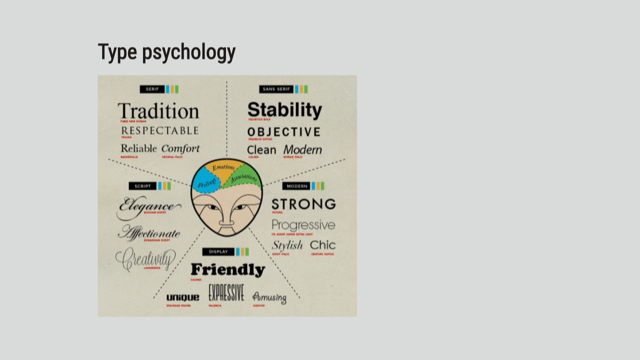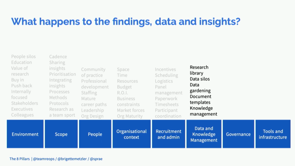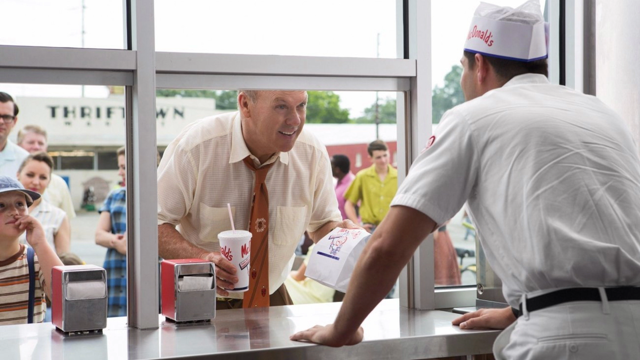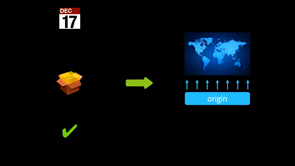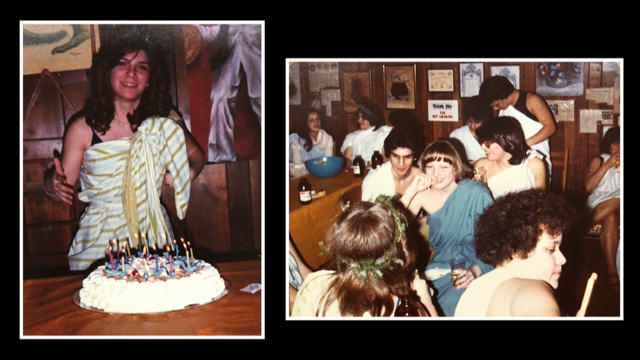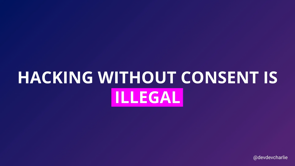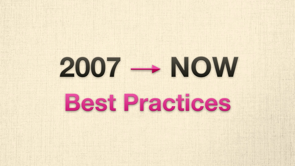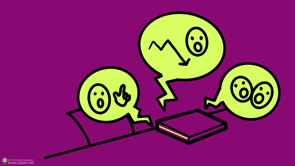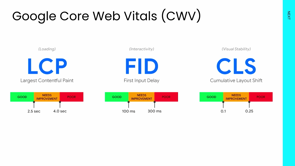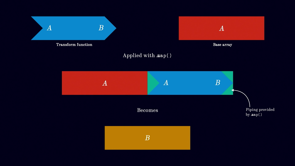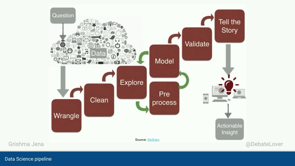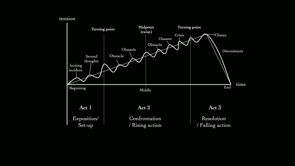
Hello everyone.
What is a story?
Seems like an innocuous question, doesn't it?
And why does it matter?
Also, another very, especially seemingly innocent question.
"The cat sat on the mat" is not the beginning of a story, but "the cat sat on a dog's mat" is John le Carré.
Otherwise, whose real name is David John Moore Cornwell.
The funny thing is both you and I know what we mean by a story when we hear it, but trying to talk about its bit of a slippery slope: it might end up talking in circles or with tautology, but there's something really fascinating about what happens to our brains when we think we're hearing a story.
It's like a switch that gets flipped.
Ever wonder why?
Some people did.
In a paper published at the end of 1980, two scientists from University of Illinois at Urbana-Champaign, William Brewer and Adam Lichtenstein, were concerned that studies done so far around how we understand the structure of stories didn't factor in our emotional responses.
In other words, the research thus far, academically speaking, has been focusing on the mechanics of story and not so much about how we feel about experiencing them.
So they devised a method to be able to analyze how we might feel throughout reading the story, and to achieve this, they took apart three stories of similar length and made different versions by rearranging the order of when things happened.
To give you a flavor, one of the stories they used was called, "The Trip Home," where a man was driving home from work, coping with minor mechanical obstacles along the way.
They had a plain, boring base version of the story, then versions with an initiating event and an outcome.
And let me give you an idea: an initiating event might be a bomb with a 10-minute timer was activated in the car as a driver gets in — drama.
The outcome, as the driver closed the door to his house, the bomb in his car exploded outside — more drama.
The other two stories were quite different, "A Day at the Beach," about a man letting his mind wonder while he relaxed on a Hawaiian beach.
I like that story, I think, and the gardener about a poor gardener raking up and burning leaves in the yard around a mansion.
Some room for conflict and poetry there, I'd say.
So they rearranged the story in six different ways.
So effectively six different versions.
And here's where it's useful to learn a little bit of terminology.
It's what we call event order versus discourse order, and it sounds exactly what it means: event order is the order in which things happen, and discourse order is how you tell the story, how you tell the sequence of things.
So, we see this concept a lot in films like: flashback.
There you go:
Discourse order, event order — not the same.
But one of my favourite examples, if you pick up a crime novel from the 1970s, you spend about a third of the book to get to know the characters, and then someone gets killed.
But if you only know, flick on your favourite TV series, like murder mystery type thing, what happens now in the first scene?
It also gives you an idea of how storytelling has changed over the years, which is also massively interesting.
I don't know, did we just get more morbid or something?
I don't know.
So, for certain versions, the scientists inserted the inciting incident and the outcome — how it ended.
So you might actually, you know, if you're reading funny stories, you might find out the outcome before the inciting incident, or you might have things happen in a straightforward chronological order, or you may have versions where some of these things are missing.
So the research asked the participants' sample of a hundred and three graduates — that felt too little to me, but never-mind, that the researcher in my head going "uhh..".
They asked them to rate how suspenseful or surprised they felt at periodic intervals throughout reading this text.
And at the end of the text, they asked them: how much of this passage is a story?
The evidence?
So texts that induce: suspense and resolution, surprise and resolution, curiosity and resolution — are considered to be stories.
So basically somebody told you one thing happened after another (A, B, C, D, E), it might not actually make a very good story.
So it might not actually even register in our minds as a story.
So this particular shift in emotion, if you like, is one of the core characteristics of what we identify a story is in our brains, but we have often struggled to explain how stories work, and we often gloss over it with, you know, use words like "hardwired".
"We are programmed through our biology to be consumers and creators of story."
Jonah Sachs in, Winning the Story Wars, his book.
And here is a friend of mine in User Research London back in 2017: Steve Portigal was speaking about research war stories, and he had a quote up, which I took a photo of.
It's by Brene Brown from her book, "Rising Strong".
The first sentence here "We're wired for story." Comes up a lot.
Or the other version is "our ancestors around the campfire" type thing.
But why?
Why?
Not happy about not knowing why.
So it took a little bit of digging. In his 2010 TED talk,
Daniel Kahneman, a world renowned psychologist, often credited to be the father of behavioural economics, but you might know him from his book, "Thinking, Fast and Slow".
Daniel spoke very succinctly about how story works in terms of how we experience the world around us.
In the studies he and his associates have conducted on happiness, they discovered a clear distinction between the experiencing self and the remembering self.
The experiencing self being the part of us that lives in the present, in the now, and the remembering self is the one that keeps score, makes sense of our lives, and the part of us that makes decisions.
He says, "Now, the remembering self is a storyteller.
And that really starts with a basic response of our memories, it starts immediately.
We don't only tell stories when we're set out to tell stories.
Our memory tells the stories, that is, what we keep from our experience is a story." And this is because they've discovered that, while the experiencing self lives its life continuously, the moments are actually lost forever.
And it's through our remembering self that we are who we are, as it were.
In his book The Origin of Stories, Brian Boyd posit some really interesting theories about why we evolved into storytelling beings.
Bit of a chunky book, but essentially he outlines the case that we solve.
We evolved a sense of narrative to help us make better strategic decisions, especially social ones.
Narrative can offer us either particular social information to guide immediate decisions or general principles we can apply in future circumstances.
Essentially, words like "programmed" and "hardwired" barely give credit to how important the story is to how we function as a species and how close it's tied to us being social mammals.
Now, I always have this question here: How many of you are cat people?
Okay, less than half, dog people?
A little more, yes, outnumbered.
Echidnas?
I don't know.
I actually realised that I didn't know this morning whether marsupials are social creatures or not, so I assumed, to some degree, that they must be.
Any case, just observe the next time your cat attacks a toy mouse or your dog catches a ball — a ball you throw.
We have a word for it; we call it "play".
And I actually think animals actually have words for it too.
We just don't know it.
Boyd argues it's one of our tools of survival as a social species, and it's how we rehearse for real confrontations one day.
But think about this for a moment: for a cat to know that the toy mouse is a toy and not a real mouse, and for the dog to know that the ball that you just threw at it is, no, it's not supposed to be destroyed, but he'll do it anyway.
It's at most — at its most basic — a recognition of a representation, it's that ability to construct an untruth, a minuscule slice of fiction, the beginning of a lie, beginning of a complex narrative we call stories.
And that's where; how close it is to us as mammals and social creatures.
Are there universal stories?
Well, so interestingly, the fascination with dramatic structures go back centuries, and I'm gonna start with Aristotle.
It's possible that there was more, that he identified more than four types of universal stories, but some of his work did not survive, so, and another American author who talked about this had 14, and Robert McKee, who's famous for his screenwriting bible called "Story", identified 25 different types of story forms.
There was a more recent study that was done: 2016: "Emotional arc of stories are dominated by six basic shapes".
They classified 1,327 stories from Project Gutenberg, which are texts —fiction—in the public domain specifically for this study through, basically, a learning computational algorithm.
However, there is a bias obviously on the Project Gutenberg, so I think we might be more accurate to mention that we refer to Western stories here.
I've been doing research on story and history of thinking about stories for a few years, and it's puzzled me that why even the most brilliant minds cannot agree.
I think the answer is because stories are so close to us, to our existence.
They're as diverse as they are, cultures and subcultures, on this planet, as there are many types of stories.
Normally around this point, I want to show this particular video, but it's a short amount of time we have today.
So I would ask you to look them up afterward.
Vonnegut has a really interesting approach at looking at story shapes, and he talks about in terms of emotional energy, emotional journey, and it was, these were part of a master's thesis in anthropology that he submitted but was rejected for University of Chicago. Very sad.
But he charts in this video, three journeys, kind of like emotional energy.
Man in hole and about getting into a hole, but somebody gets into trouble, gets out again.
So that sort of blue line there, boy gets go, but it doesn't have to be a boy.
It doesn't have to be a girl.
Start on average day, average person not expecting anything.
Find something wonderful, fall in love, loses it, and get it back again, and that's that kind of a yellow curve.
Oh, sorry, button backwards.
The "Boy Meets Girl," the blue one and the "Man in Holes," the yellow one.
The pink one there is a "Cinderella arc," where it's, in his video, Kurt Vonnegut talks about being a universal, sort of western story shape, but actually we are finding that Cinderella stories also exist in parts of Asia and quite a lot of other places.
You might be more familiar with the 3-acts structure, which is used in just about everything.
It was popularised by Syd Field in his 1979 book screenplay, "The Foundations of Screenwriting." So the 3-acts are the exposition, confrontation, and resolution.
In the first act, you know, get to meet all characters, know the world, and things get more tense as the protagonist or the hero, fight for what, he, they wanted throughout the story.
It usually ends up in a big fight at the end, and, usually, hopefully, the hero wins, in which case it's a good story; otherwise, it's a tragedy if they don't get what they want.
You may also be familiar with "The Hero's journey." We're not, I'm not gonna go in depth with this one; it's a lot in there, but maybe the classic example of the hero's journey would be Luke Skywalker in Star Wars.
Yes!
We all know that one, but you may not be aware that there is a "heroine's journey." Now, it's a gendered language because, thank you, Joseph Campbell, who called it the Hero's Journey.
So now we have to call it something else.
The hero may not need to be male, and the heroine may not need to be female.
So, for example, the Wonder Woman, is actually a hero's journey story, and Harry Potter was actually a heroine's journey story.
So the difference, there's a number of differences, but the main one I can think of and to explain it is the hero's journey.
The hero goes off, finds their power, usually at the climax of the story, and goes at it alone.
The heroine's journey is more about ....
So usually, the heroine here, again, not necessarily female, has something taken from her: maybe a family strong bond tie; and throughout the search to get that back, they go through, you know, built community and friendships and relationships that helps them through to get back what they lost.
How many of you have seen Wednesday?
Oh, yeah!
Okay.
All right.
So I know this is, yeah, I'm, I binged it on the way on the plane.
So, my, I would love to know what you think, but my take is that Wednesday starts off as a hero but ends up in the heroine's journey.
So I would love to know what you think.
There are many more story structures than just a 3-act, just a hero's journey.
Yeah, just a Freytag pyramid.
The Wikipedia page is actually pretty good.
Check it out.
Actually, it's a good list of different types of story forms, but a compatriot of mine, Kim Yoonmi, has been collecting worldwide story structures and it's a really brilliant and very, very long Tumblr post that's probably an interesting reference.
One of the better studied non-Eurocentric story structures is the East Asian 4-act, known Kishōtenketsu, my apologies to Japanese speakers in the audience.
I'm not Japanese-speaking, so please correct my pronunciation later.
It was originated in China, but also used in Korean Japanese fiction.
Just interpretation in different countries is just ever so slight.
However, it's studied mostly for the form, that is, a conflict-free type story structure.
Let me break it down for you.
"Ki," a scene is set; "Sho", you have no built more on the characters and the relationships.
And "Ten" is the climax, usually an unforeseen event that does not have to do anything with the first two acts, but it complicate things and "Ketsu", which is the resolution, and it focuses on sort of the backwards lens to see how you make sense of things.
The film "Parasite" does this one very well.
Have we seen "Parasite"?
Okay, a few more.
The storm, that's a "Ten" moment, the moment you go, "Oh crap," and, everything changes.
So that's how it works in kishōtenketsu.
Okay, so in the context, there's a change in perspective, which makes you reevaluate the events that have preceded it and creates tension that way.
So it's about causality rather than conflict that drives this type of story telling.
And sometimes it makes me wonder what kind of world we would live in — if the main story form that's dominant isn't conflict-driven.
We could be living in such a different world.
So in other words, in when you think about other story forms, conflict is not necessarily the core element, and that it may take a community, not a lone hero.
Cartesian dualism doesn't apply to all cultures, and we see this a lot in genre fiction and the conversation there.
By Cartesian dualism, I mean, what is real, what is physical, and what is magical/spiritual
May not have such a hard line in non-European centric cultures.
And agency only works if you already have power.
So if you know people who are from an oppressed culture, they will have different story forms because of it.
This is actually from the before times.
Some of you may have read this article when it came out.
Well, which is quite well referenced, I was surprised at how many people knew about this.
Zeynep Tufekci, Turkish Writer, academic, associate professor at the School of Information and Library Science at the University of North Carolina, wrote about this, about how basically the writers for the last season did a switch on us, and that was why it was so unsatisfying.
It changed the storytelling style from sociological to psychological, essentially from that sort of complex.
Everybody has, actually, you know what?
I have a good quote here that she explains it.
Sorry, I'll send it.
We'll find ways to get you the links, but I'm sure you can search right.
"In sociological storytelling, the characters have personal stories and agency, of course, but those are greatly shaped by institutions and events around them." It's so much more reflective of the society that we live in.
A great example of this is The Expanse.
Hey, no, no surprise that I'm using all the sci-fi.
The Expanse is brilliant at doing this, and I'm actually thinking.
I was wondering this morning, like, does "Andor" qualify as well because it's also yet another one that has very extremely complex, society-type stories.
But this is where I had that sort of like clinch point in my head.
"If we can better understand how and why characters make their choices, we can also think about how to structure our world that encourages better choices for everyone." When we conduct design research, we are seeking to understand how people arrive at decisions, and when we design, we are thinking, looking to help people make better decision.
Kind of big ones.
Is this the house I should buy?
All the way down to is this the right button to click?
Like decisions come big and small and, we are, we, already know that people don't always do what they say they would, but we could really go further to understand why they do what they do based on how they, sort of craft the story around themselves and how we belong in that story.
So, story structures are good, but story principles are far more useful in my practice as somebody who has been using story for, particularly design research.
More than half the books and resources out there would tell you that stories need to have conflict — and they don't.
It's around the emotional change, and this one is Will Storr in "The Science of Storytelling" a book I highly recommend "Every story you'll ever hear amounts to something changed." Our job as designers, as researchers is to map that change.
The implications, the before, the after, and the consequences.
Because usually when you and I show up to the scene as designers, as digital folks, we are part of that change, and it's our responsibility to know what impact we will have.
That's why stories are important.
Here's a useful little tool.
It's a useful little tool from Greg Mosse, a writing teacher I met a number of years ago.
He didn't have a name for this, so I call it the story source triangle, and the idea he, the way he explained it, was if you have a sequence of events in a place, and, you know, what kind of person would inhabit that space?
What kind of character?
If you've got, you know, a character in a place, what would happen?
So using this little sort of triangle, you can come up with basically any story, and I loved that it was a great concept, but one of the things I realized very, very swiftly is you can use this in an interview.
If somebody, no, when someone talks about a character, I'll dive deep about that; same with place or sequence of events.
However, we might also do it the other way.
If they talk a lot about a place, I might focus on two other aspects.
Just ask them about it, and that way you create the space and having that framework for your users to tell you their stories in great depth, and with great emotional depth.
And I can attest to that.
So with this particular framework, I've actually developed a number of random little tools for different circumstances.
One of them is, like, I ran this workshop once for a local district council, and we, basically ,realised that they had some really negative language about their users.
So we're talking about citizens, right?
In, you know, in a district.
I think that's like, think about it as local government.
They have these words like the occupier.
Just like you're just taking up space.
It's a terrible way to describe citizens.
So we ran this workshop to look at and thinking about words for, and, basically like using, imposing the words for archetypes on users to understand, how we might better firstly change the minds in terms to make it more positive so that you would design for people that you actually respect.
The Collective Story Harvesting is a method that is often used by facilitators for social causes.
Usually, you know, the storytellers share the stories, and people who harvest, listen, and gather or harvest on story themes.
I haven't used this exact method, but I've used similar principles in a research setting where I've harvested in a room of story listeners.
Listening out for specific themes and making sure that we play that back to our participant or the storyteller.
There's also using time, a blameless way of cause analysis.
So, you know, people will have different ways of doing retros, but if, you know, map out a sequence of this is what happened, this is what happened next, this is what happened afterwards, and also just any number of other things that drive the cause and effect, can it allow you to basically diagnose what went wrong.
There's also, real quick mention of The JTBD/Switch Interview.
So, it's a narrative interview approach that harnesses an events based narrative framework, and this is one of those that works really well in try and get in depth of things, or you might have some fun using the Karpman's Drama Triangle.
Do your users view themselves as a victims of a business context and, you know, look to your software and app for rescue?
Interesting little model to use.
This one came from Eric Berne, a Canadian-born psychiatrist, created the theory of transactional analysis as a way of explaining human behavior.
So, what kind of stories should we look for?
I'm just gonna have a real quick list.
Origin stories, purchase decision or commitment stories, because not every story is around buying.
The work-around story is one of the most fascinating ones because it also shows up different goals that the user's really trying to do if you can find out what they're working around.
Slice of life, particularly moments of change again, because change are what stories about.
And for me, the shifting between life stages is what makes interesting change.
So, life stages are, you know, when you first go to school, when you first go to secondary school, when you get your first job, when you first fall in love, or when your children leave home.
Now, these moments in someone's lives are usually when certain needs arise and, you know, give rise to the context of how we might explain things.
So I've spoken a lot about research.
Interestingly, there was peak discussion about design and storytelling between, I'm can be exact about this, 2010 and 2013.
And then it sort of died.
I love this video so much because it's like the user storytelling know, diverged into social media, interactive media, data visualization, and it's possible that the rise in responsive design meant that some richest storytelling elements become sort of dissolved away from the design patterns that we have.
I don't know; something happened, we no longer have it very much in design.
We also went back to things like craft of words.
There was one exception I found recently, and this is an app, a wellbeing, sort of holistic health app called Fabulous.
On the left-hand side is like me, my future self making contract with me, present-day me, and then they have got this sort of journey thing on here, which is a really quick little snippet and, so in theory it looks great.
So, you know, you get the First Mountain, the Second Mountain, it's like 3-act in an app and in the Second Mountain.
Go on.
I wish I could move faster.
Okay.
So like different obstacles I'm supposed to go through.
But it's really weird because you can't, like, you get stuck on the journey.
You can't get off it if it doesn't apply to you.
So an interesting idea, but maybe not the best execution.
So yeah, I was stuck on the drinking water thing, which is I was, but I already drink water.
I don't need to.
Anyway.
This is the Airbnb site as of yesterday.
Clean design, beautiful design for utility.
There was a trickle of discussion from about 2016 where we realized that without story, our interfaces and experiences become bland as design patterns become codified.
And maybe not a surprise because this is what Airbnb maybe used to look like in 2015 and 2016, is so much of a more of an emotional appeal, and we've seemed to have moved away from that.
I don't know what's right or wrong.
I think it's just an interesting observation.
There's just so much warmth in this particular execution that you don't see in the utilitarian design that we have that's sort of more fashionable today.
There's a tendency to talk about design if it's flattened on the screen, and Steve Souders and Mark Zeman had a slide which captured exactly what I was saying at BTConf, Beyond Conference in 2015.
Because in your user's mind the story begin before they arrive at your app and can continue a long time after they leave.
So the encounter speaking somewhere here, they may come to your brand story, then your service story; once they start using the app, the content, the visuals, and the time that they spend on your app or website is kind of like limited to that, but the story, it service is longer before and end.
And so, maybe the slice of life, ongoing context change, might actually be a more useful model for our users' stories because when, now again, when we show up, it's the time for change.
And again, I'm just gonna repeat this quote because it's so good.
"If we can better understand how and why people make the choices, we can also think about how to structure our world to encourage better choices for everyone." And that, my friends, is one of the privileges that we have as designers, and I think we should take our responsibility very seriously.
Thank you very much.
